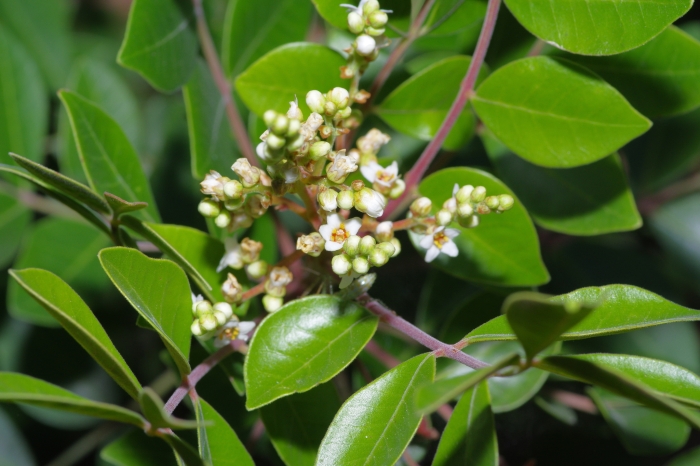Evergreen Sumac
(Rhus virens)
Evergreen Sumac (Rhus virens)
/
/

Michelle W.
CC BY 4.0
Image By:
Michelle W.
Recorded By:
Copyright:
CC BY 4.0
Copyright Notice:
Photo by: Michelle W. | License Type: CC BY 4.0 | License URL: http://creativecommons.org/licenses/by/4.0/ | Rights Holder: Michelle W. | Publisher: iNaturalist | Date Created: 2021-09-19T08:13:25-07:00 |



















































Estimated Native Range
Summary
Rhus virens, commonly known as Evergreen Sumac or Tobacco Sumac, is an evergreen shrub native to a variety of habitats including rocky hillsides, canyons, and scrublands in the Southwestern United States and Northern and Central Mexico, extending as far south as Oaxaca. It typically grows to a height of 8-12 feet (2.4-3.7 meters) and a similar spread, featuring a dense, rounded form. The plant produces clusters of small, creamy-white flowers in late summer to early fall, which are followed by red berries that persist into winter and are attractive to wildlife.
Evergreen Sumac is valued for its drought tolerance, low maintenance requirements, and the year-round visual interest it provides with its glossy, leathery leaves and persistent fruit. It is used in xeriscaping, as a screen or hedge, and in naturalistic plantings. It thrives in full sun to part shade and prefers well-drained soils, tolerating a range of soil types from sandy to clay. While generally disease-resistant, it can occasionally suffer from root rot in poorly drained soils. Evergreen Sumac is not known for aggressive roots or significant pest problems, making it a reliable choice for gardeners. It is also important to note that while it is in the same family as poison ivy, it does not cause skin irritation.CC BY-SA 4.0
Evergreen Sumac is valued for its drought tolerance, low maintenance requirements, and the year-round visual interest it provides with its glossy, leathery leaves and persistent fruit. It is used in xeriscaping, as a screen or hedge, and in naturalistic plantings. It thrives in full sun to part shade and prefers well-drained soils, tolerating a range of soil types from sandy to clay. While generally disease-resistant, it can occasionally suffer from root rot in poorly drained soils. Evergreen Sumac is not known for aggressive roots or significant pest problems, making it a reliable choice for gardeners. It is also important to note that while it is in the same family as poison ivy, it does not cause skin irritation.CC BY-SA 4.0
Plant Description
- Plant Type: Tree, Shrub
- Height: 6-8 feet
- Width: 8-10 feet
- Growth Rate: Moderate
- Flower Color: N/A
- Flowering Season: Summer, Fall
- Leaf Retention: Evergreen
Growth Requirements
- Sun: Full Sun, Part Shade
- Water: Low
- Drainage: Fast
Common Uses
Bee Garden, Bird Garden, Butterfly Garden, Deer Resistant, Drought Tolerant, Fragrant, Hedges, Hummingbird Garden, Low Maintenance, Rabbit Resistant, Rock Garden, Street Planting
Natural Habitat
native to a variety of habitats including rocky hillsides, canyons, and scrublands in the Southwestern United States and Northern and Central Mexico, extending as far south as Oaxaca
Other Names
Common Names: Tobacco Sumac
Scientific Names: , Rhus virens, Rhus virens var. virens, Schmaltzia virens,
GBIF Accepted Name: Rhus virens Lindh. ex Gray